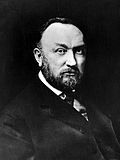History

It was William Fletcher Barrett's visit to America that ultimately led to the formation of the American Society for Psychical Research in December, 1884. [3] Barrett was invited by several members of the American Association for the Advancement of Science. He persuaded intellectuals such as Edward Charles Pickering, Simon Newcomb, Alexander Graham Bell, Henry Pickering Bowditch and William James that the claims of psychical phenomena should be investigated scientifically. [3]
The first meetings of the society were held in the rooms of the American Academy of Arts and Sciences. [4] The founding members who were also the first Vice-Presidents were G. Stanley Hall, George Stuart Fullerton, Edward Charles Pickering, Henry Pickering Bowditch and Charles Sedgwick Minot. [5] Other founding members were Alpheus Hyatt, N. D. C. Hodges, William James and Samuel Hubbard Scudder. [6] The mathematician Simon Newcomb was the first President. [7]
Other early members included the psychologists James Mark Baldwin, Joseph Jastrow, and Christine Ladd-Franklin. [8] [9] Initial research findings were discouraging. [10] By 1890, members such as Baldwin, Hall, Jastrow and Ladd-Franklin had resigned from the society. [9] Hall and Jastrow became outspoken critics of parapsychology. [11] Morton Prince and James Jackson Putnam left the ASPR in 1892 to form the American Psychological Association. [12]
Richard Hodgson joined the ASPR in 1887 to serve as its secretary. [13] In 1889, Fullerton, James and Josiah Royce were Vice-Presidents and Samuel Pierpont Langley served as President. [5] In 1889, a financial crisis forced the ASPR to become a branch of the Society for Psychical Research, and Simon Newcomb and others left. [14] Following the death of Hodgson in 1905 it achieved independence once more. [15]
In 1906, James H. Hyslop took up the position as secretary of the recreated organization, with the work being done at his residence in New York City. He once wrote his son, "My work is missionary, not mercenary." The intended name for the new organization was, "The American Institute for Scientific Research" which Hyslop had organized into two sections for the investigation of two separate fields: "A" was to deal with psychopathology or abnormal psychology. [16] Its Section "B" was to be concerned with what Hyslop called "supernormal psychology" or parapsychology. Section "A" never got off the ground. But Section "B" became the new and reorganized ASPR. One of the Institute's aims was to organize and endow investigations into telepathy, clairvoyance, mediumship, and kinetic phenomena. This work was to be carried out by "B." [17] The society remained in New York, where it remains as of 2015. During this period the ASPR was heavily involved in the investigation of medium Leonora Piper about whom William James would famously declare in 1890: "To upset the conclusion that all crows are black, there is no need to seek demonstration that no crow is black; it is sufficient to produce one white crow; a single one is sufficient." Since his proclamation of Piper as his "one White Crow", the concept of the single "White Crow" has become a cliché in psychical re-search. [18]
After evaluating sixty-nine reports of Piper's mediumship William James considered the hypothesis of telepathy as well as Piper obtaining information about her sitters by natural means such as her memory recalling information. According to James the "spirit-control" hypothesis of her mediumship was "somewhat incoherent, ambiguous, irrelevant, and, in some cases, demonstrably false—at best only circumstantial." [19] However, G. Stanley Hall believed Piper's mediumship had an entirely naturalistic explanation and no telepathy was involved. Hall and Amy Tanner, who observed some of the trances, explained the phenomena in terms of the subconscious mind harboring various personalities that pretended to be spirits or controls. In their view, Piper had subconsciously absorbed information that she later regurgitated as messages from "spirits" in her trances. [20]
On June 20, 1906, the ASPR had 170 members and by the end of November 1907, it had 677. [17] Hereward Carrington became a member of the ASPR in 1907 and an assistant to James Hyslop until 1908, during which time he established his reputation as an ASPR investigator. However his connection with the ASPR ceased due to lack of funds. [17] Carrington was the author the book The Physical Phenomena of Spiritualism which exposed the tricks of fraudulent mediums. [21] According to Arthur Conan Doyle, Carrington was not popular with spiritualists. [22]
James Hyslop died in 1920, and immediately strife broke out between the membership as the Society divided into two factions, one broadly pro-Spiritualism, indeed often Spiritualists, and the other 'conservative' faction favoring telepathy and skeptical of 'discarnate spirits' as an explanation for the phenomena studied, or simply skeptical of the phenomena's existence. [23] In 1923 a prominent Spiritualist, Frederick Edwards, was appointed President, and the conservative faction led by Gardner Murphy and Walter Franklin Prince declared that the Society was becoming less academic. [24] In the same year the ASPR lost 108 members. [25] New members joined the society and William McDougall a past President and Prince both became alarmed at the number of "credulous spiritualists" that joined the ASPR. [26]
In 1925 Edwards was reappointed President, and his support of the mediumistic claims of 'Margery' (Mina Crandon) led to the 'conservative' faction leaving and forming the rival Boston Society for Psychical Research in May, 1925. From this point on the ASPR remained highly sympathetic to Spiritualism until 1941, when the Boston Society for Psychical Research was reintegrated into the ASPR. [23]







